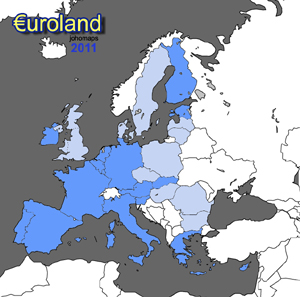|
Obsolete Currencies in the Eurozone:
*Northern Cyprus, though not recognized by the European Union, is not part of the Eurozone. |
Note: Euros are not equivalent to the
former European Currency Unit (ECU)
[More Info] (XE.com) Euro (From Wikipedia) Note: The euro (symbol: €; banking code: EUR) is the official currency of the European Union and single currency for over 300 million Europeans in the following twelve European Union member states: Austria, Belgium, Finland, France, Germany, Greece, Ireland, Italy, Luxembourg, the Netherlands, Portugal and Spain; collectively also known as the eurozone. The euro was introduced to world financial markets in 1999 and launched as a currency in 2002. The euro is strongly advancing both economic and political integration among the participating EU member states. All EU member states are eligible to join if they comply to certain monetary requirements. The euro is managed and administered by the Frankfurt-based European Central Bank (ECB) and the European System of Central Banks (ESCB) (composed of the central banks of its member states). As an independent central bank, the ECB has sole authority to set monetary policy. The ESCB participates in the printing, minting and distribution of and coins in all member states, and the operation of the eurozone payment systems.
The above rates were determined by the Council of the European Union, based on a recommendation from the European Commission based on the market rates on 31 December 1998, so that one ECU (European Currency Unit) would equal one euro. (The European Currency Unit was an accounting unit used by the EU, based on the currencies of the member states; it was not a currency in its own right.) These rates were set by Council Regulation 2866/98 (EC), of 31 December 1998. They could not be set earlier, because the ECU depended on the closing exchange rate of the non-euro currencies (principally the pound sterling) that day. Greece failed to meet the criteria for joining initially, so it did not join the common currency on 1 January 1999. It was admitted two years later, on 1 January 2001, at the following exchange rate:
Slovenia became a member of the Eurozone Jan 1, 2007. The Euro replaces the tolar as the only currency of Slovenia at the exchange rate of:
Malta and Cyprus became members of the Eurozone Jan 1, 2008 at the exchange rates of:
|
